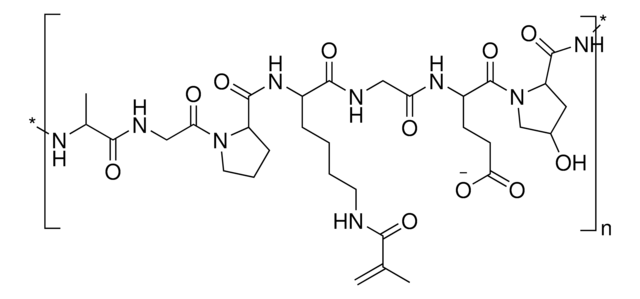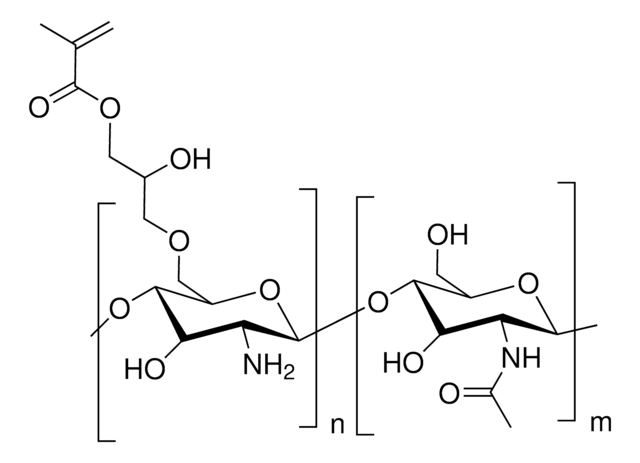938424
TissueFab® Discrete GelMA
90-110 bloom, 50% degree of substitution
Sign Into View Organizational & Contract Pricing
All Photos(1)
About This Item
Linear Formula:
(C32H48N9O11)n
UNSPSC Code:
51171641
NACRES:
NA.21
Recommended Products
Quality Level
description
Application: 3D bioprinting, tissue engineering
form
powder or chunks ( or fibers)
color
white to light brown
storage temp.
−20°C
Related Categories
General description
Gelatin methacryloyl, also known as gelatin methacrylate or GelMA, is a methacrylate-functionalized gelatin biomaterial. The gelatin amine groups are chemically modified with methacrylate groups, which when combined with light and a photoinitiator, can be be photopolymerized to form a hydrogel with a three-dimension network that closely mimices the native extracellular matrix (ECM). GelMA is often used as a scaffold for cell culture and tissue regeneration, as it provides a supportive environment for cell attachment, proliferation, and differentiation. Its properties, such as mechanical strength, degradation rate, and gelation behavior, can be adjusted by modifying the degree of methacrylation and crosslinking density.
Many GelMAs currently available have a high degree of variation and inconsistency. To address this, the TissueFab(R) Discrete GelMAs have been developed to achieve a specific degree of methacrylation with low batch to batch variability.
Many GelMAs currently available have a high degree of variation and inconsistency. To address this, the TissueFab(R) Discrete GelMAs have been developed to achieve a specific degree of methacrylation with low batch to batch variability.
Application
- Tissue engineering - including bone tissue, cartilage tissue, epidermal tissue, and cardiac tissue
- Regenerative medicine - including injectable tissue constructs and endothelial cell morphogenesis
- Drug and cell delivery - in the form of microspheres and hydrogels
- Surface coatings - of medical devices and implants in order to improve biocompatibility and release therapeutic cargos
Features and Benefits
- Specific degree of methacrylation - a narrow peak of methacrylation allows for better reproducibility, low batch to batch variability, for improved consistency of gel properties and cell behavior.
- Biocompatibility - GelMA contains RGD sequences, found in collagen and other natural ECM proteins, which promote cell adhesion, proliferation, differentiation, and maturation of a variety of cell types.
- Biodegradability - GelMA contains matrix metalloproteinase (MMP) degradable sites that can be recognized and enzymatically degraded by cells. This allows the encapsulated cells to degrade and remodel the GelMA matrix, and repopulate with their own cells and tissues, a major goal for tissue engineering and regenerative medicine.
- Tunability - The TissueFab(R) Discrete GelMAs are available in a variety of degrees of substitution which ultimately impact the hydrogel stiffness and mechanical properties and can be used to recapitulate and accomodate different native tissues.
- Bioprintability - The TissueFab(R) Discrete GelMAs are widely used in the field of 3D bioprinting due to their unique gelation properties and the ability to print via extrusion and other methods to create intricate cell-encapsulated 3D structures with high cell viability.
Legal Information
TISSUEFAB is a registered trademark of Merck KGaA, Darmstadt, Germany
related product
Product No.
Description
Pricing
Storage Class Code
11 - Combustible Solids
WGK
WGK 3
Flash Point(F)
Not applicable
Flash Point(C)
Not applicable
Certificates of Analysis (COA)
Search for Certificates of Analysis (COA) by entering the products Lot/Batch Number. Lot and Batch Numbers can be found on a product’s label following the words ‘Lot’ or ‘Batch’.
Already Own This Product?
Find documentation for the products that you have recently purchased in the Document Library.
Photocrosslinkable gelatin hydrogel for epidermal tissue engineering.
Zhao X, et al.
Advanced Helathcare Materials, 12 (2015)
Direct-write bioprinting of cell-laden methacrylated gelatin hydrogels.
Bertassoni LE, Cardoso JC, Manoharan V, et al.
Biofabrication, 6(2), 024105-024105 (2014)
Mineralized gelatin methacrylate-based matrices induce osteogenic differentiation of human induced pluripotent stem cells.
Kang H, Shih YR, Hwang Y, et al.
Acta Biomaterialia, 10(12), 4961-4970 (2014)
Cell-laden microengineered gelatin methacrylate hydrogels.
Nichol JW, Koshy ST, Bae H, et al.
Biomaterials, 31(21), 5536-5544 (2010)
The 3D printing of gelatin methacrylamide cell-laden tissue-engineered constructs with high cell viability.
Billiet T, Gevaert E, De Schryver T, et al.
Biomaterials, 35(1, 49-62 (2014)
Our team of scientists has experience in all areas of research including Life Science, Material Science, Chemical Synthesis, Chromatography, Analytical and many others.
Contact Technical Service







